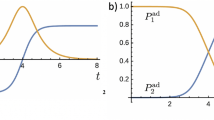
Overview
- Nominated as an outstanding PhD thesis by Simon Fraser University, Canada
- Advances understanding of rare events in thermodynamic systems
- Defines a thermodynamic measure of the relevance of a particular degree of freedom to a reaction
Part of the book series: Springer Theses (Springer Theses)
Access this book
Tax calculation will be finalised at checkout
Other ways to access
About this book
This thesis addresses deep questions that cut to the physical and informational essence of central chemical quantities such as transition paths and reaction mechanisms and proposes fundamental new connections between transition-path theory, linear-response theory, nonequilibrium thermodynamics, and information theory. The author investigates slow, energetically efficient driving protocols that drive a system between conformations corresponding to endpoints of a reaction, aiming to find connections between principles of efficient driving and the spontaneous transition mechanism in the absence of driving. First, an alternative perspective of transition-path theory is developed that unifies it with stochastic thermodynamics to describe flows of entropy, energy, and information during the reaction. This also provides an optimization criterion for selecting collective variables. Next, protocols are designed which invert the magnetization of a 3×3 Ising model with minimal energetic cost,and it is determined that using multiple control parameters allows the system to be driven along a fast-relaxing pathway between reaction endpoints. Finally, the author compares these protocols with the spontaneous transition mechanism for magnetization inversion in the same Ising model, finding that designed protocols capture general features of the spontaneous mechanism and energetics given the constraints on the control parameters. This work represents a major step forward in our understanding of rare events and provides a basis for investigating the connection between efficient protocols and spontaneous transition mechanisms which can be further probed in a wider variety of systems.
Similar content being viewed by others
Keywords
Table of contents (6 chapters)
Authors and Affiliations
About the author
Dr. Miranda Louwerse obtained a Bachelor of Science in Chemistry and Mathematics from the University of the Fraser Valley in 2017 before beginning a PhD in Chemistry at Simon Fraser University. She joined Dr. David Sivak’s research group in the physics department and carried out interdisciplinary research at the intersection of chemistry, physics, biology, and statistics. Upon completing her PhD in 2022, Miranda found employment as a data scientist in the biotech industry. Miranda has been married to her husband Mitch since 2018 and spends her time fishing with him and her two-year old border collie Roscoe.
Bibliographic Information
Book Title: Efficient Control and Spontaneous Transitions
Authors: Miranda Louwerse
Series Title: Springer Theses
DOI: https://doi.org/10.1007/978-3-031-40534-1
Publisher: Springer Cham
eBook Packages: Chemistry and Materials Science, Chemistry and Material Science (R0)
Copyright Information: The Editor(s) (if applicable) and The Author(s), under exclusive license to Springer Nature Switzerland AG 2024
Hardcover ISBN: 978-3-031-40533-4Published: 27 October 2023
Softcover ISBN: 978-3-031-40536-5Due: 27 November 2023
eBook ISBN: 978-3-031-40534-1Published: 26 October 2023
Series ISSN: 2190-5053
Series E-ISSN: 2190-5061
Edition Number: 1
Number of Pages: XIII, 113
Number of Illustrations: 2 b/w illustrations, 21 illustrations in colour
Topics: Thermodynamics, Biological and Medical Physics, Biophysics, Biochemistry, general, Inorganic Chemistry, Organic Chemistry, Theoretical and Computational Chemistry



